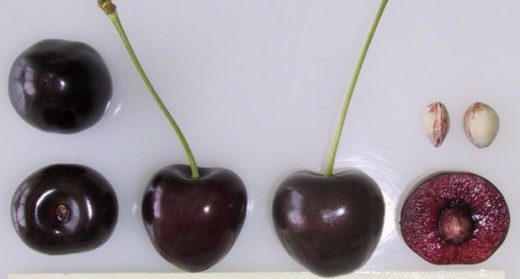KORDIA CHERRY TREE
Except for cold parts of the UK, Kordia is a highly under-rated cherry tree. It produces the “blackest” colour of all the cherries, it is resistant to canker and splitting, the cherries are large, fleshy and tasty.
Its only failing is that the blossoms can be affected by frosts but it does flower mid to late in the season, normally around the first week of May. We highly recommend it.
Use the checklist below to decide if the Kordia cherry tree variety is correct for you and your garden. If this is not the correct variety, see our cherry tree varieties page, to select another variety which may suit you better.
- The fruits of Kordia are produced mid season, ready for eating, on average, in the second week of July.
- Fruits are of larger than average size. They are red to dark red and have a sweet but also acid flavour with a firm texture.
- The picking period lasts a week.
- Kordia was a chance seedling found in the Czech Republic, the parents are not known.
- This variety reliably produces a large amount of fruit.
- Disease resistance is excellent, especially to canker and fruit-splitting.
- Kordia is self-sterile and needs a pollination partner (see below).
- Gained the Award of Garden Merit from the Royal Horticultural Society in 2014.
- It is fully hardy in all parts of the UK (however, see above about blossom).
WHERE TO BUY KORDIA CHERRY TREES
Kordia often to be found in your local garden centre and is also available online from a several suppliers.
Picture from public sector information licensed under the Open Government Licence v2.0.
POLLINATION PARTNERS FOR KORDIA CHERRY
Kordia is in pollination group 4, self-sterile, it needs a pollination partner. The following are suitable cherry tree varieties commonly grown in the UK:
- Van, pollination group 3, eating variety
- Penny, pollination group 3 to 4, eating variety
- Summer Sun, pollination group 3 to 4, eating variety
- Stella, pollination group 4, cooking variety
- Sunburst, pollination group 4, eating variety
- Morello, pollination group 4, cooking variety
- Napoleon, pollination group 4 to 5, cooking variety
HOW LARGE WILL KORDIA GROW
On Colt rootstock Kordia will grow to about 3.5m / 11ft tall when it has reached maturity after about 7 years. It can easily be pruned to reach a maximum height of 2m / 7ft. On Gisela 5 rootstock it will grow into a 2m / 6ft tall tree but will need more care than if grown on a Colt rootstock.
ALTERNATIVES TO KORDIA
Click on the box below to see the full range of cherry tree varieties which we have reviewed in detail. Click on any one of them to see the full variety review.
CONDITIONS FOR GROWING KORDIA CHERRIES
The following are the key rules for growing this variety, click here for more detailed information about growing and pruning cherry trees:
- Plant and grow in a full sun position.
- The best time to plant Kordia is in late autumn to early winter. It can be planted at other times of year but will require watering more frequently to ensure it establishes well.
- Plant the tree to the same depth as it was in the pot. If planting bare-rooted trees you will see a natural soil mark just above the roots which indicates the correct depth for planting.
- Spread an 8cm / 3in layer of mulch around the base of the tree but not touching the main trunk. A mulched circle of about 1m / 3ft will be sufficient. This will retain moisture in the soil below and greatly help the tree to establish well.
- Water very well immediately after planting.
- Stake the tree for its life on a Gisela 5 rootstock. On Colt rootstock the tree will only need staking for the first two years of its life.
- In the first summer after planting the tree, water well if conditions become dry.
- Prune Kordia in the first year according to the suppliers instructions. Prune annually immediately after flowering in later years, in late July. See our detailed article on pruning cherry trees.
- An annual mulch in late Spring will help to retain moisture and an even supply of water.
- If any pests or diseases appear treat them as soon as possible. Consult our cherry tree pest and disease page for detailed information on identifying and treating problems.
